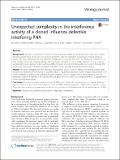Files in this item
Unexpected complexity in the interference activity of a cloned influenza defective interfering RNA
Item metadata
| dc.contributor.author | Meng, Bo | |
| dc.contributor.author | Bentley, Kirsten | |
| dc.contributor.author | Marriott, Anthony C. | |
| dc.contributor.author | Scott, Paul D. | |
| dc.contributor.author | Dimmock, Nigel J. | |
| dc.contributor.author | Easton, Andrew J. | |
| dc.date.accessioned | 2017-07-25T09:30:14Z | |
| dc.date.available | 2017-07-25T09:30:14Z | |
| dc.date.issued | 2017-07-24 | |
| dc.identifier | 250562590 | |
| dc.identifier | 69bb1adc-5ed7-4bc5-95ce-ca40e5429b03 | |
| dc.identifier | 85025587757 | |
| dc.identifier | 000406578400003 | |
| dc.identifier.citation | Meng , B , Bentley , K , Marriott , A C , Scott , P D , Dimmock , N J & Easton , A J 2017 , ' Unexpected complexity in the interference activity of a cloned influenza defective interfering RNA ' , Virology Journal , vol. 14 , no. 1 , 138 . https://doi.org/10.1186/s12985-017-0805-6 | en |
| dc.identifier.issn | 1743-422X | |
| dc.identifier.other | RIS: Meng2017 | |
| dc.identifier.other | ORCID: /0000-0002-6619-2098/work/60427671 | |
| dc.identifier.uri | https://hdl.handle.net/10023/11279 | |
| dc.description | Funding: Medical Research Council (Grant No. G0600832). | en |
| dc.description.abstract | Background: Defective interfering (DI) viruses are natural antivirals made by nearly all viruses. They have a highly deleted genome (thus being non-infectious) and interfere with the replication of genetically related infectious viruses. We have produced the first potential therapeutic DI virus for the clinic by cloning an influenza A DI RNA (1/244) which was derived naturally from genome segment 1. This is highly effective in vivo, and has unexpectedly broad-spectrum activity with two different modes of action: inhibiting influenza A viruses through RNA interference, and all other (interferon-sensitive) respiratory viruses through stimulating interferon type I. Results: We have investigated the RNA inhibitory mechanism(s) of DI 1/244 RNA. Ablation of initiation codons does not diminish interference showing that no protein product is required for protection. Further analysis indicated that 1/244 DI RNA interferes by replacing the cognate full-length segment 1 RNA in progeny virions, while interfering with the expression of genome segment 1, its cognate RNA, and genome RNAs 2 and 3, but not genome RNA 6, a representative of the non-polymerase genes. Conclusions: Our data contradict the dogma that a DI RNA only interferes with expression from its cognate full-length segment. There is reciprocity as cloned segment 2 and 3 DI RNAs inhibited expression of RNAs from a segment 1 target. These data demonstrate an unexpected complexity in the mechanism of interference by this cloned therapeutic DI RNA. | |
| dc.format.extent | 16 | |
| dc.format.extent | 2644857 | |
| dc.language.iso | eng | |
| dc.relation.ispartof | Virology Journal | en |
| dc.subject | Influenza virus | en |
| dc.subject | Defective interfering RNA | en |
| dc.subject | Replication | en |
| dc.subject | Interference | en |
| dc.subject | QR355 Virology | en |
| dc.subject | NDAS | en |
| dc.subject.lcc | QR355 | en |
| dc.title | Unexpected complexity in the interference activity of a cloned influenza defective interfering RNA | en |
| dc.type | Journal article | en |
| dc.contributor.institution | University of St Andrews. School of Biology | en |
| dc.contributor.institution | University of St Andrews. Biomedical Sciences Research Complex | en |
| dc.identifier.doi | 10.1186/s12985-017-0805-6 | |
| dc.description.status | Peer reviewed | en |
This item appears in the following Collection(s)
Items in the St Andrews Research Repository are protected by copyright, with all rights reserved, unless otherwise indicated.

